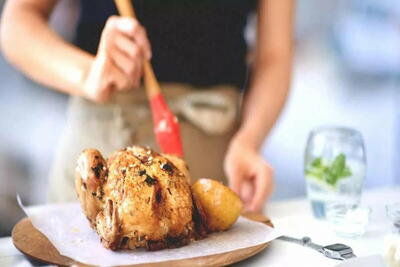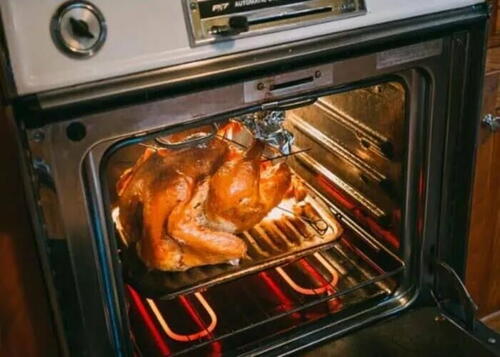How to Cook a Whole Chicken

Learn How to Cook a Whole Chicken! Preparing a chicken can be intimidating, especially with the high stakes of preparing one for a holiday meal. Don't chicken out! Be up for the challenge and use this guide to help you. This source provides you with all of the key information to prepare the perfect fried or roast chicken for your holiday feast. Review the safety concerns, the essentials with respect to chicken internal temperature, and how the processes differ between frying and roasting a chicken.
Be sure to check out the ChefsTemp Finaltouch X10 Thermometer Giveaway as part of our Christmas in July celebration! You'll also want to enter to win the Christmas in July Foodie Grand Prize!
Cooking MethodFrying, Roasting
Pair your chicken with this Fluffy Focaccia Bread Recipe!Fluffy Focaccia Bread Recipe
Safety Concerns When Cooking Chicken
-
When it comes to cooking chicken, the number one rule is to achieve the ideal internal temp. It is not just a matter of taste or texture, but that of safety for anyone who consumes the meat.
-
Chicken, and other types of poultry, are known to contain salmonella. Therefore, it is important that you cook chicken properly to ensure that you don’t consume salmonella when eating the meat. There is nothing to worry about this type of bacteria, as long as you properly cook the meat.
-
The recommended guideline for food safety is that you need to achieve a certain temperature level to ensure that bacteria in the meat are killed. For chicken, it is 165℉ or 74℃. A lot of people do not take the time to check the chicken’s internal temperature and only base it on physical indicators. However, this is not a reliable approach when checking if the chicken is done, because it is what is inside that matters.
-
A lot of people assume that when the chicken meat is firm, it’s done. But when this happens, all of the proteins in the meat have squeezed out much of the water resulting in a meat that is dry. Checking the color is also unreliable. Pinkness of the meat is not just based on the temperature; pH of the meat can be a factor.
-
When it comes to food safety, using steps that are unreliable or flawed can be a huge risk. Even when the meat looks cooked, the bacteria in the meat might not be killed off yet. You should always check the chicken’s internal temp to make sure you have properly cooked it.
Chicken Internal Temp: What You Need to Know
-
Getting the ideal chicken internal temp is a must because there is a tendency for most people to overcook chicken in fear of any food-borne illness. And you would not want to eat dry chicken.
-
In order to achieve the right temperature of the chicken meat, you have to think about many other temperature calculations. You need to get the right temperature in the oven (when roasting chicken), the internal temperature of the chicken, to make sure it is cooked, and the temperature to check for the quality of the meat.
-
There are two types of meat in a chicken. The white meat like the breast will require a different temperature to be properly cooked. You need to achieve 165 degrees F of the internal temperature of the chicken breast for at least 30 seconds. You must keep checking the chicken breast’s internal temperature. Once it reaches 162℉(72℃), it can maintain that internal heat and will continue to rise to 165℉(74℃). This is the secret to cooking chicken breast to prevent overcooking and causing the meat to become dry.
-
The dark meat of the chicken refers to the thigh. Unlike the breast, the thigh (dark meat) will require a higher temperature to cook. The ideal temperature to cook the thigh of the chicken is at 175-180℉(79-82℃). This is due to the higher amount of connective tissues in this part of the chicken.
-
If you cook the thigh at a lower temperature – say 165℉(74℃) – it will result in a chewy and rubbery meat. But if you increase the temperature, it will allow the collagen to melt and make the meat tender.
Internal Temperature for Chicken: Roasting and Frying
Achieving the ideal temperature of the chicken will also vary depending on the cooking method used. There are two common methods of preparation of chicken: roasting and frying.
-
When roasting chicken, especially a whole chicken, it is important to get the right internal temp. To get the perfect roast, preheat the oven to 500℉(260℃). Place the kitchen on a roasting rack and place it in the middle of the oven. Reduce the oven temperature to 350℉(176℃).
-
Use a digital meat thermometer and insert it in the deepest part of the chicken breast. Once the internal temperature has reached 162℉(72℃), the meat is done. Remove the chicken from the oven and let it rest before carving the meat.
-
When frying the chicken, you want to achieve that golden crust on the outside and juicy meat in the middle. The temperature of the oil is a critical factor to achieve the best fried chicken and to make sure that it is properly cooked. You need high smoke point oil for this, such as peanut oil and vegetable oil. Make sure the oil temperature is at 350℉(176℃) before you place the chicken into the pan.
-
Once you’ve placed the chicken in the oil, don’t overcrowd the pan. When you put too much chicken in the oil, it will cause the temperature of the oil to drop. It is important to maintain the cooking temperature of the oil so it cooks evenly. It is also a crucial step to keep your fried chicken crispy. If the oil temperature drops, the chicken will absorb the oil and make it soggy. The safest internal temperature for fried chicken is a minimum of 165℉(74℃).
-
Getting the right temperature is a top priority when it comes to cooking chicken to ensure safety. It is also crucial to make sure that the meat stays juicy, tender, and succulent. It takes a balance between both, but once achieved, you can enjoy your chicken however you like to prepare it.
Fried Chicken- Breast and Thigh
Why do people love fried chicken? Because it is juicy, tender, and crunchy. What is the secret to great fried chicken?
-
The great fried chicken starts with a good quality chicken. In today’s modern grocery store you can buy whole chickens, chicken breast, thighs, legs, wings, already cooked, raw, frozen. But if you want great fried chicken, start with a whole chicken and cut it up yourself.
-
Once you have your chicken cut up for frying, save the legs, wings, and back for stock or soups. Today we are going to concentrate on frying the breast and thigh portions only.
-
First, we need to season the chicken, then we are going to make some seasoned flour using the same seasoning we used on the chicken and coat our chicken in flour, once it is coated, then we will work on frying the chicken.
-
Once our chicken is coated we need to get our oil heated up in a heavy pan, and then make sure we are heated to 350℉(176℃) and then place our chicken in the oil skin side down.
-
Once you get your chicken browned on the skin side, turn it over and let it continue to cook. The thighs will get to temp before the breast does and you will remove them from the frying oil and continue cooking the breast.
-
The pull temperature for the thighs is between 170-180℉(76-82℃). Chicken thighs are dark meat and can handle a higher pull temperature. This is after fifteen minutes of resting.
-
Chicken breast needs to reach 165℉(73℃) and because it is so thick, it is a good practice to get it browned and then pull it from the fryer and finish it in an oven set to 350℉(176℃). If you do this, the chicken breast will be tender, juicy, the skin will stay crispy and the chicken won’t be overcooked from being in the fryer. This is the secret to great fried chicken, hot oil, fresh chicken, and finish in the oven if you are cooking chicken breast. Make sure you use your ChefsTemp Final Touch X10 throughout the cooking process to get the chicken exactly perfect.
Roasted Whole Chicken
-
When preparing a chicken for roasting it is important to season it well, I used salt, black pepper, granulated garlic and onion. While you are preparing the chicken have your oven preheating to 500℉(260℃). Once you get your chicken seasoned place it on an oven roasting rack, turn the oven down to 350℉(176℃), and place it in the oven.
-
Set a kitchen timer for 30 minutes and when your timer goes off, take a temperature reading in the thickest part of the breast and in the thigh. You are looking to get the breast to 165℉(73℃), and most of the time, the thigh will be between 180⁰F and 210⁰F, this is normal, the thigh meat do to it being dark meat and having more internal fat and a heavily used muscle will benefit from the higher pull temperature.
-
Once your chicken reaches the desired temperature, you need to remove it from the oven and let it rest for 20 minutes before cutting into the chicken, this allows the juices to return to the center of the chicken and will be moist, juicy, and tender with nice crispy skin.
-
Make sure the chicken is up to temperature before it comes out of the oven, use your ChefsTemp Final Touch X10 to test the internal temperature.


